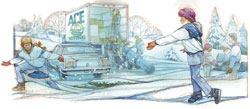![]() November-December 2000
November-December 2000

By Victor M. Parachin
Illustration by Joel Snyder

What do Barbra Streisand, Kevin Costner, Johnny Carson, and Carol Burnett have in common? True, they are all performers in the public eye, but what they a lso have in common is shyness. Each experiences the dictionary definition of shyness: "not at ease with other people; bashful; to be cautious or unwilling." In spite of being shy as children and even as adults, they have not allowed this trait to hold them back from pursuing successful careers.
Various studies show that nearly half of all people consider themselves to be shy. For example, in 1975, Stanford University psychologist Philip Zimbardo surveyed 800 students at various American colleges. He found that 40 percent of those questioned considered themselves to be shy. Dr. Zimbardo has continued to survey people and says that since 1975, the prevalence of shyness has risen from 40 percent to 48 percent of people. One reason for the increase in shyness is the growth of technology: More and more people spend time communicating via e-mail, faxes, voice mail, and cell phones. In fact, only 5 to 7 percent of Americans consider themselves persistently personable and outgoing.
Yet, Streisand, Costner, Carson, and Burnett are good examples of people who overcame shyness so that it didn't take a toll on personal happiness and professional success. Parents and other significant adults can help a child overcome shyness. Here are eight steps to take:
Provide some direction or even assistance. Without taking over a child's life and making all decisions for him, a parent can and should provide assistance from time to time.
Consider the example of Steve Crawford, age 9, and his mother. After the family moved to Columbus, Ga., Steve had difficulty making new friends. One day, another family with a boy close to Steve's age moved to the same street. "Let's walk over and say 'hello,'" Steve's mother offered. Together they made the visit and within half an hour, Steve and his new friend, Pat Mullins, were playing in the yard.
Their friendship firmed up and grew through the decades. The two weathered many of life's twists and turns together. That lifelong friendship might never have been forged had Steve's mother not taken the time to get involved and persuade Steve to reach out.
Do some homework with your child. If a child is going to a party, have him/her find out who will be there, where they go to school, what interests they have. Psychologists call this technique "social reconnaissance."
If your child has been invited to a party but is hesitant or fearful, those concerns can be relieved by making some discrete inquiries. Will there be other children your child knows? If so, knowing that will probably make him or her more comfortable about attending. If there is no one your child knows well, then the task is to encourage him to view the opportunity as one of getting to know some new people and broadening his circle of friendships.
Parents should remember that it is important for their child to show up. While the easy path may be to avoid situations which are uncomfortable, such avoidance does not help in overcoming shyness.
"Nothing succeeds in overcoming shyness as much as experiencing social successes. But in order to succeed, you must be willing to go out and practice," says psychologist Lynne Henderson, Ph.D., director of The Shyness Clinic in Palo Alto, Calif. Doing some social reconnaissance with your child for upcoming holiday events and parties, for example, will help him or her gain such social success.
Use role-playing. Children have vivid imaginations. Utilize that gift by encouraging your shy child to create a "character" or role which is an unshy version of himself. Then have the child mentally rehearse scenes in which the unshy character moves effortlessly in social settings.
This type of role-playing was used by one mother to help her 11-year-old son feel more comfortable about attending a birthday party at which he did not know most of the other children.
"I challenged Robb to pretend he was a movie actor playing the role of someone who was very extroverted," his mother says. "Over and over we practiced his 'lines.' He would pretend I was a stranger and would approach me with his hand extended saying: 'Hi. My name is Robb. I've seen you at school but don't know your name.' I would shake his hand and give him my name. Then we would practice some small talk.
"Robb came home from the party absolutely elated because the practice paid off and he made two new friends."
Help a child pay attention to body language. Shy, introverted people can send out signals of being distant, detached, and withdrawn. This can easily be corrected by paying attention to body language, says psychologist Arthur Wassmer, author of Making Contact: A Guide To Overcoming Shyness (Henry Holt & Co., 1990).
Dr. Wassmer uses a one word reminder to list all the body-language signals which project warmth: soften. The S stands for "smile," the O for "open posture" (legs and arms uncrossed). The F is for "forward lean," the T for "touch" or friendly physical contact such as shaking hands. The E stands for "eye contact"—looking directly at the person—and the N for "nod," which affirms one is listening and understanding.
Promote the taking of small steps. At age 12, Chad was physically smaller than most boys his age. Many of his friends played on an ice hockey team, but Chad held back from trying out from a combination of shyness and concern about his size.
"I realized that Chad could play hockey and it would help him be closer friends with the other players, but he was too timid to even consider trying out for the team," his father says. Then the father learned that the local rink was offering hockey classes for beginners, so he asked Chad if he was interested. "Yes" was his enthusiastic reply.
"I signed him up, and he took a one-hour class every Saturday morning for eight weeks," his father said. "By the end of that time, he was skating forward and backward quite well. In addition, he learned how to stick and puck handle. His confidence boomed quickly." When the regular hockey season began that fall, Chad was there for tryouts and made the team.
With new friends from the hockey team, Chad became interested in other sports as well and began to challenge himself to succeed in new ways. Chad's comfort zone was broadened because his father promoted the taking of a small step by enrolling in a few hockey classes. Small steps can yield large results for shy children.
Challenge kids to drop perfectionism. Like many adults, children tend to be far too hard on themselves. Children need reminders that they don't have to perform perfectly at social events—don't have to tell the funniest jokes, be the most popular at school, be the highest-scoring athlete—in order to have healthy social interactions.
Many children set standards so high that they are impossible to achieve and thereby set themselves up for failure. Parents should help their children set more realistic goals and standards.
Cultivate the fine art of encouragement. The quickest route to social success is by complimenting and encouraging other people. Shy children also tend to be sensitive and empathetic individuals. Remind children that increasing their attention to others in positive ways boosts the intensity of involvement, making them more socially appealing. Teach your child how to give a compliment, offer encouragement, or provide consolation to a friend who is hurting. "Altruism is an antidote to shyness," notes Dr. Henderson. "Helping, giving, sharing—all these things take you out of yourself and make social interactions more pleasant."
Remind children that there's always another chance. Don't let a child mistakenly believe that because of one failure, he or she is permanently doomed. So if your child was afraid to speak to his coach, too self-conscious to raise her hand in class to ask the teacher a question, or too timid to reach out to a new student, point out that he or she has simply missed one opportunity. Remind them that they always have another chance. The next day encourage that child to speak to the coach, ask the teacher, or reach out to the new student.
Help the bashful child realize that, despite a possible initial urge to avoid it, there's probably a perfect opportunity to practice being unshy waiting for him or her around the corner.
Victor Parachin writes from Tulsa, Okla.
Copyright © 2000 by the Boy Scouts of America. All rights thereunder reserved; anything appearing in Scouting magazine or on its Web site may not be reprinted either wholly or in part without written permission. Because of freedom given authors, opinions may not reflect official concurrence.
| The Boy Scouts of America | http://www.scouting.org |